Who would have thought that only two years after the wonderful and detailed travel around Crete I could come again to this beautiful Greek island (see: https://www.svudapodji.com/en/crete-1/).
The occasion was quite good and sufficient for me to decide easily to take this step. Namely, the previous year, Saša Marinković, a friend and ornithologist whom I had mentioned in my stories before, hinted that we would go to Crete in 2024 and I immediately said that I was interested. However, I didn’t know exactly when we would go and when he mentioned spring at the beginning of the year, I was initially worried because I had already planned a trip in April. Still, fate decided that I could go on this trip as well, because it was organised at the beginning of May when two holidays coincided in Serbia, so with just a few days off work, it was possible to have a quite decent “vacation” of 10 days.
Just as in 2023 when I went with a group of ornithologists and bird lovers to Greece and Bulgaria (see: https://www.svudapodji.com/en/greece-bulgaria-1/) primarily to see the cinereous or (Eurasian) black vulture, this time about a dozen of us went to Crete to see, among other things, the bearded vulture. This would complete the “holy” trinity of large Balkan birds of prey, as there is a large colony of griffon vultures in Serbia. As for Serbia, cinereous vultures have been occasional visitors in recent years, but the bearded vulture has long been extinct, while the restoration of its population is difficult, not only in Serbia.
To start with, we took a plane via Athens to Heraklion, the capital of Crete. From there, using rented cars, we drove to the town of Malia, where we would be staying for the entire duration of our visit to the island.
I had no idea how our stay on the island would be organised and I don’t think there was any strict organisation at all. This is quite unusual for me, as I like to “know everything” in advance, but this time I was exceptionally relaxed. Before the trip, I even joked with Sonja, a friend I met through “my birders” (as I like to call this group of bird enthusiasts), with whom I now regularly hang out and with whom I embarked on this trip, that I would let the trip organisers surprise me. And that’s exactly how it turned out, with some wonderful surprises.
Here is also a map that shows the places and sites I visited during this trip:
Since we arrived at an exceptionally beautiful apartment complex in Malia late on the first evening, the plan was for everyone to have breakfast late as well. However, Sonja and I had already had coffee on the terrace before breakfast, which was incredibly pleasant with the beautiful blue sky that probably stood out even more because of the pool within the apartment complex.
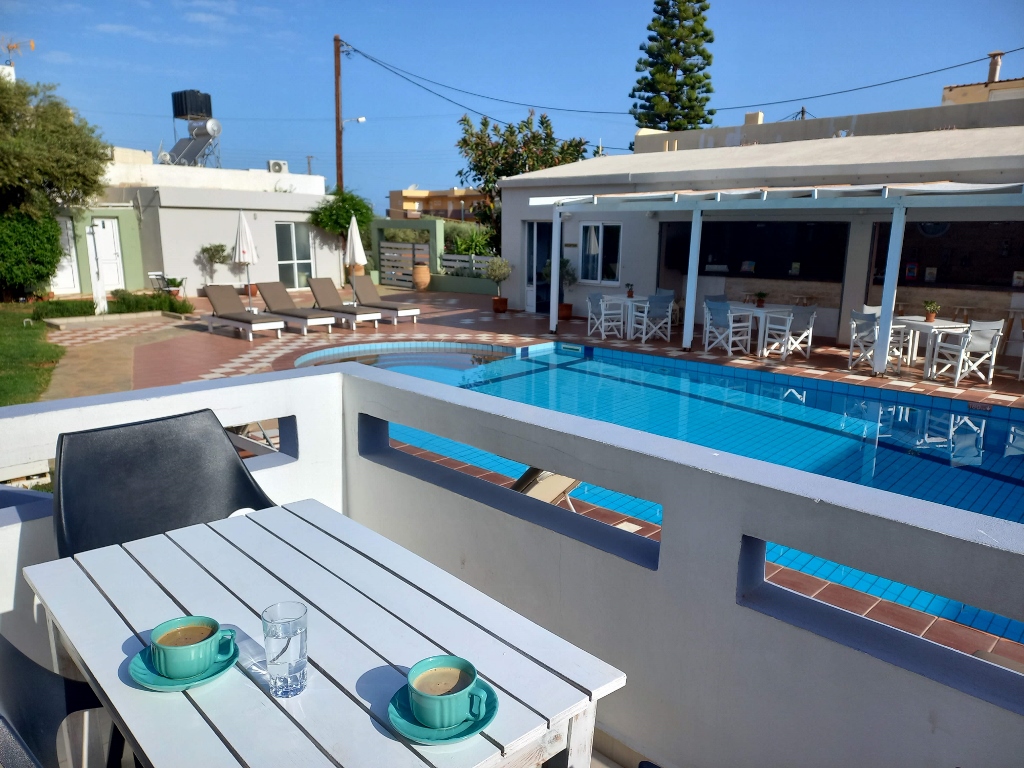 Morning coffee in Malia
Morning coffee in Malia
Malia is known as a place where young people like to gather in the summer and, to put it mildly, party all night, but at the beginning of May, the season still hadn’t started and there was peace all around.
After breakfast, we all continued to drink coffee and relax in the pleasant shade of the apartment complex terrace. As the sun slowly started to warm the air, it increasingly felt like the beginning of summer and it was clear that we were in the heart of the Mediterranean.
At some point, we all got moving, piled into the cars and drove just a few kilometres further, as there are potentially nice spots for bird-watching in the Malia area. Of course, it was easier for the experts in our group to spot and identify the species, but the rest of us also enjoyed the beautiful and relaxing day.
First, we drove to an area near the sea and took a short walk there.
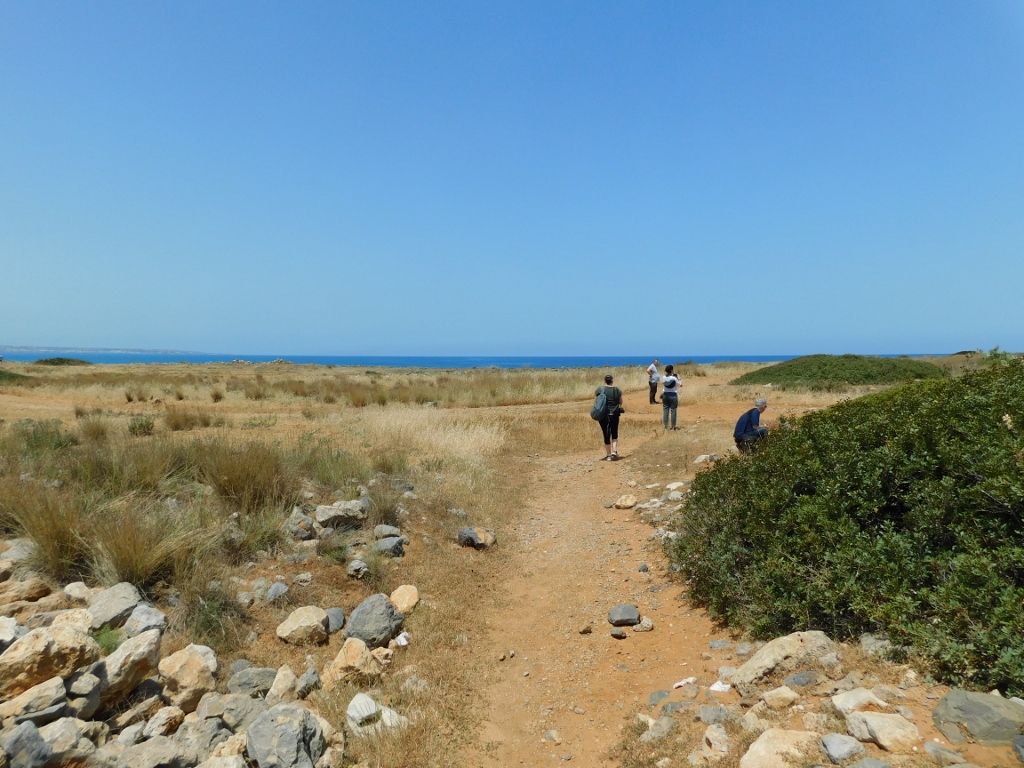 Walking near Malia
Walking near Malia
From this slight elevation, we could look out at the beautiful blue sea. Formally speaking, it is the Bay of Malia within the Sea of Crete, which is a part of the Aegean Sea. But does the sea even know what it is called?
 Sea along the north coast of Crete
Sea along the north coast of Crete
We could also see from here the beaches of Malia that are so popular during summer.
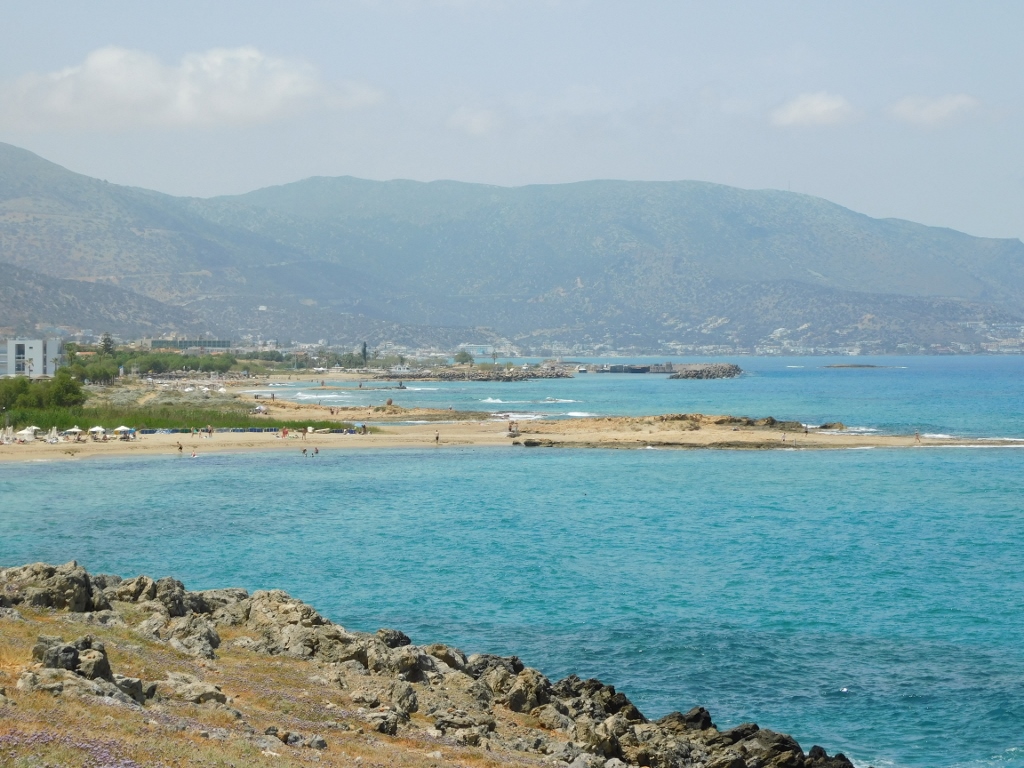 View at the beaches f Malia
View at the beaches f Malia
Here, we scattered a bit, each of us focusing on something different, with birds being the main attraction. However, I’m not very skilled at spotting birds, especially the smaller ones that fly quickly or change direction so swiftly, so I initially observed the motionless living beings, like some plants that caught my eye.
There was a lovely plant called Cretan viper’s bugloss (Echium creticum).
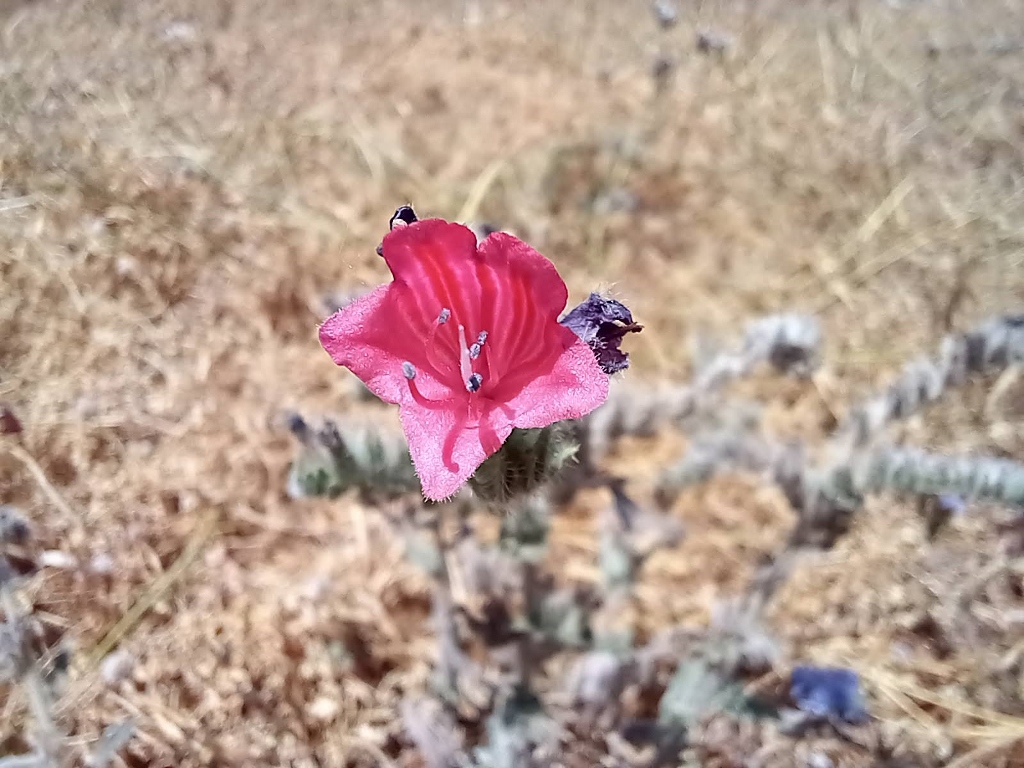 Cretan viper’s bugloss
Cretan viper’s bugloss
In some places, there were proper “carpets” made of flowers, such as numerous examples of the sea lavender (Limonium sinuatum).
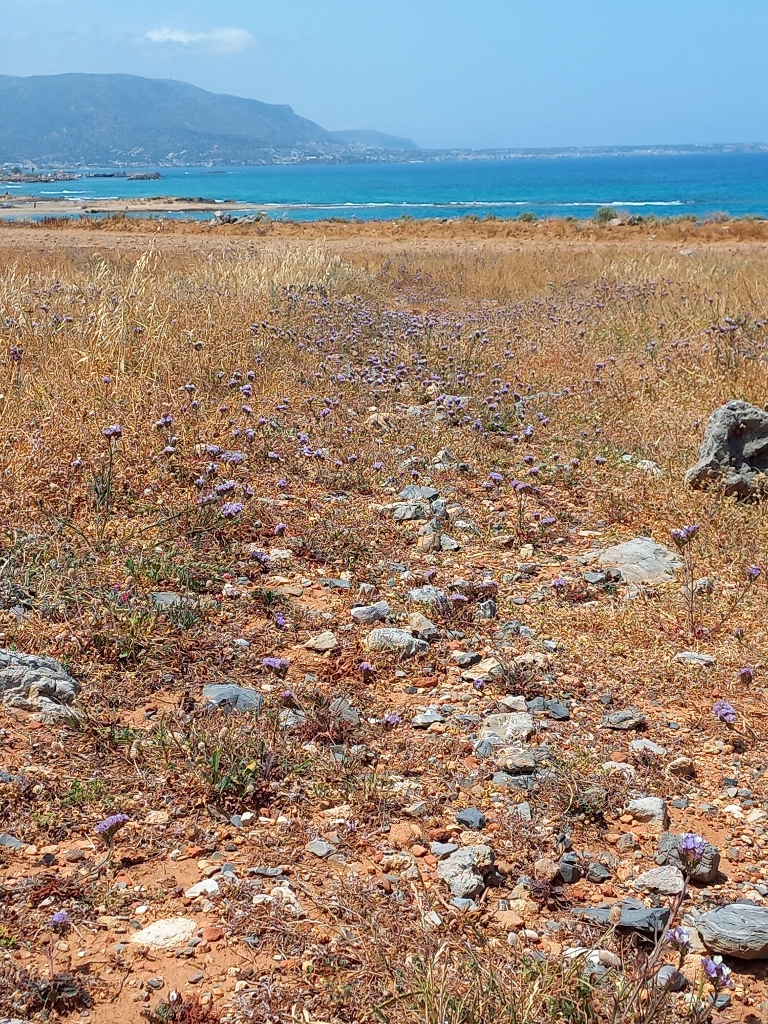 Sea lavender
Sea lavender
While I was trying to capture some sea lavender up close, another living creature appeared and it was a mammoth wasp (Megascolia maculata). Although it is the largest wasp in Europe, it is completely harmless to humans.
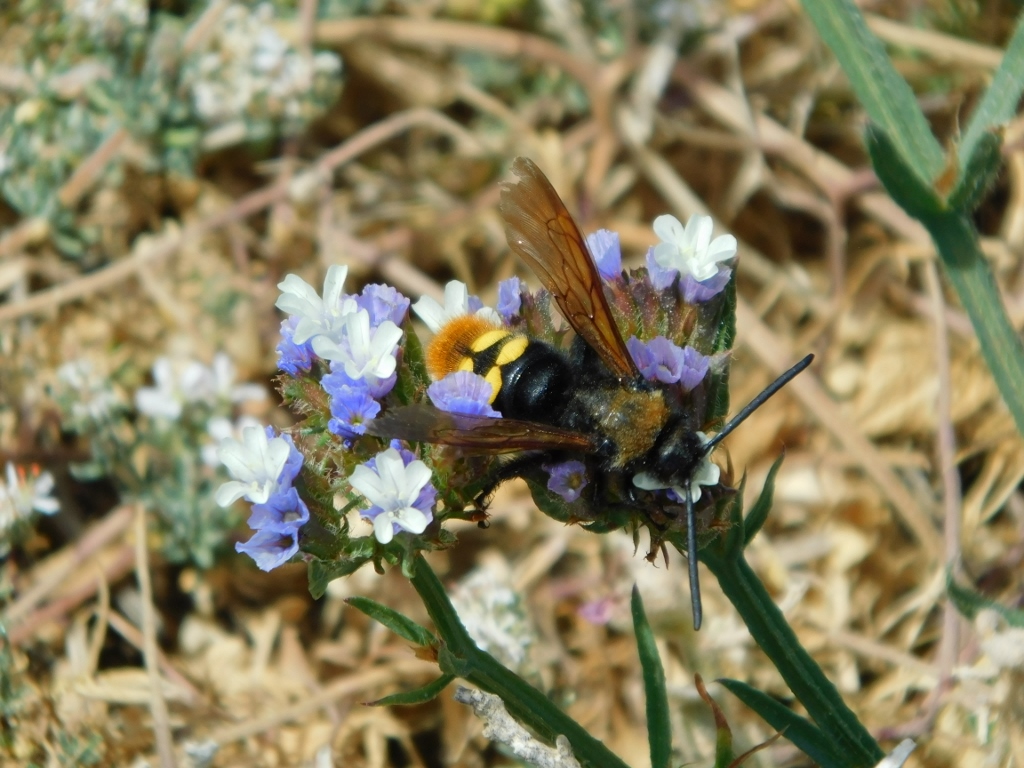 Sea lavender and a mammoth wasp
Sea lavender and a mammoth wasp
The appearance of this wasp here was quite fitting, as it is believed that this species was the inspiration for the famous gold pendant found not far from where I captured the wasp. It is called the “Bee Pendant,” which can be seen not only in the Heraklion Archaeological Museum, but also in my travel stories from Crete of 2022 (see: https://www.svudapodji.com/en/crete-5/).
But, we came here for the birds, so it’s only fair that I pay some attention to them. Of course, the ornithologists from our group, Saša, Irena and Vuk, were the main ones for species recognition and Vuk diligently kept a journal of the observed birds, which he later shared with all of us. I should say right away that they saw many more species than I managed to capture, but in the end, I was still satisfied with my performance. By the way, I should mention that the yellow wagtail was recorded here during its migration, as it does not nest in Crete.
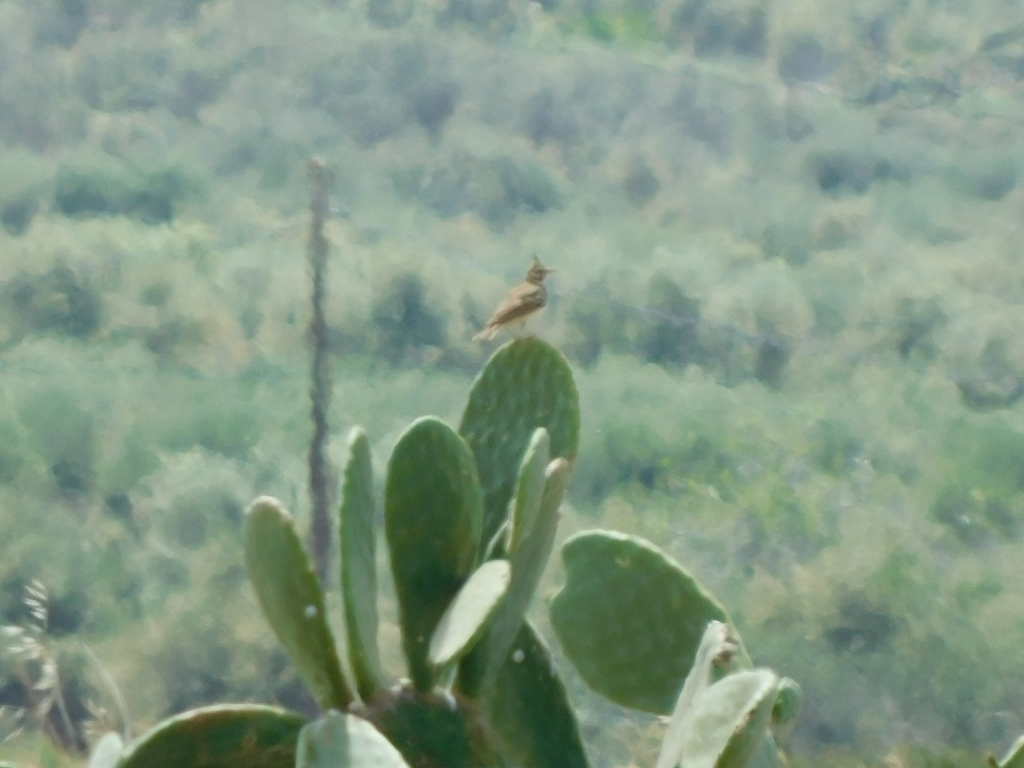 Crested lark (Galerida cristata)
Crested lark (Galerida cristata)
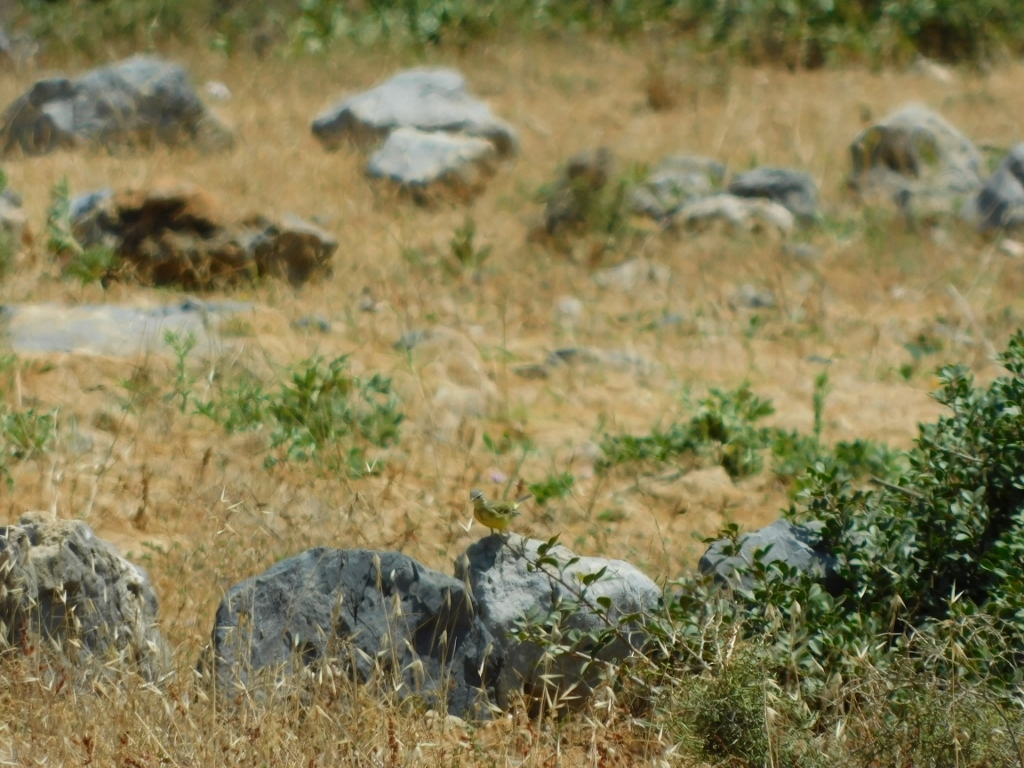 Western yellow wagtail (Motacilla flava)
Western yellow wagtail (Motacilla flava)
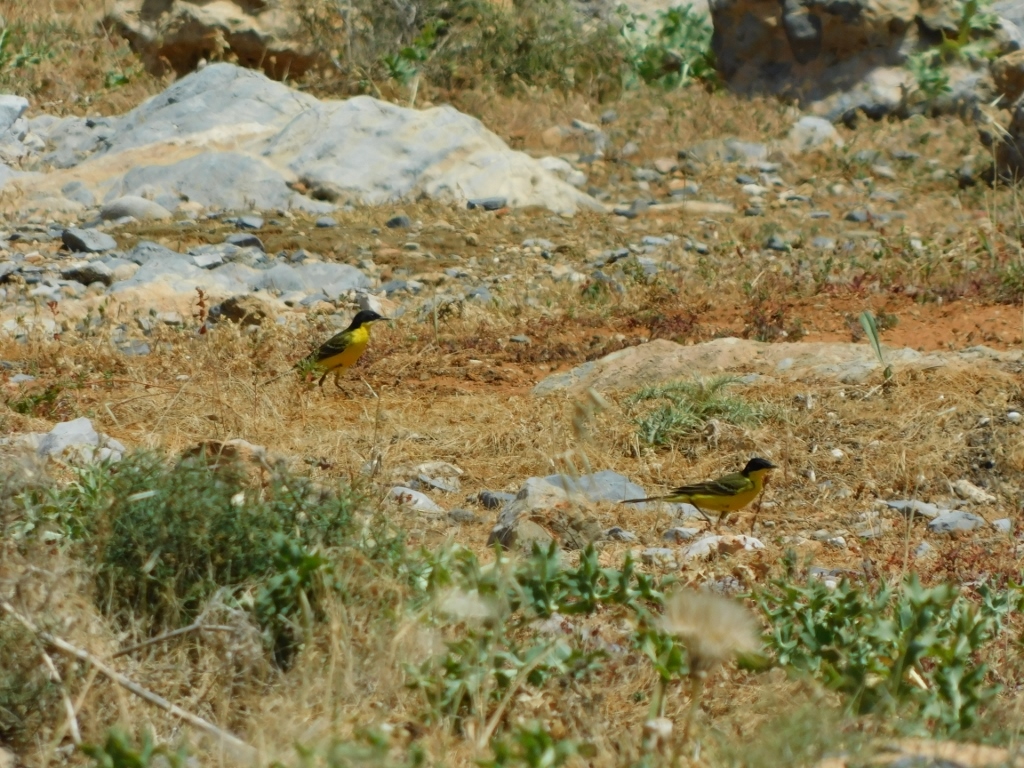 Black-headed yellow wagtail, sub-species of western yellow wagtail (spp. feldegg)
Black-headed yellow wagtail, sub-species of western yellow wagtail (spp. feldegg)
I was particularly pleased to have captured a European bee-eater (Merops apiaster) in mid-flight.
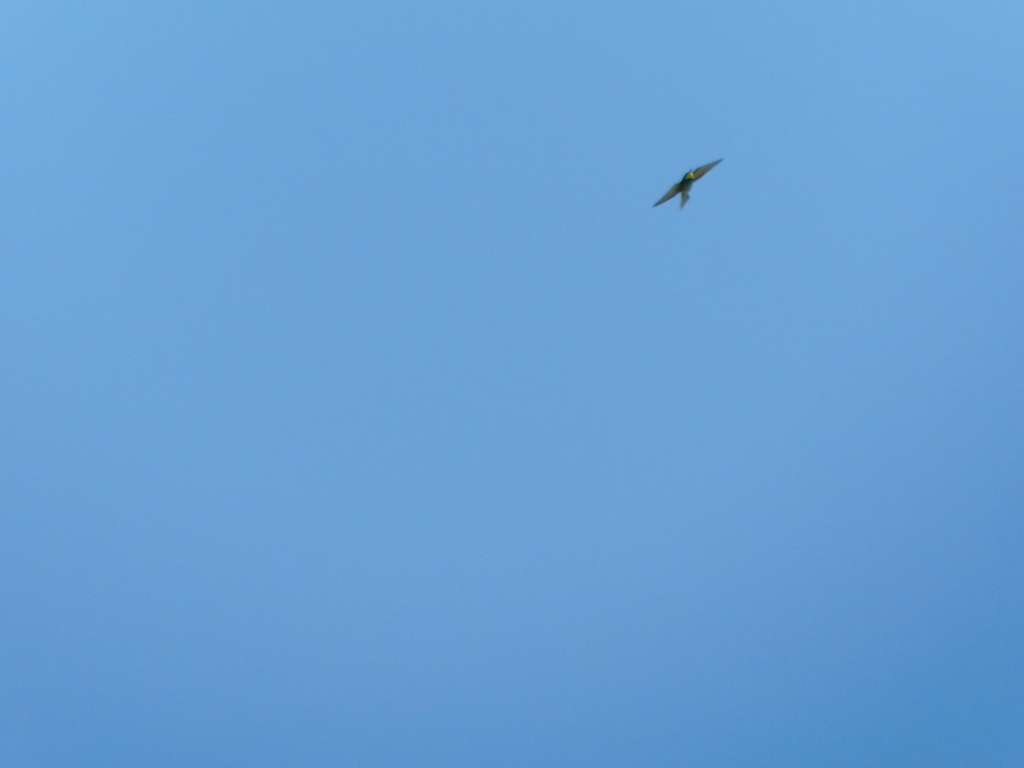 European bee-eater
European bee-eater
Since we were very close to the archaeological site of Malia (Malia Palace), after some time, we went there to visit the Minoan palace. Considering that I had already been here two years earlier (see: https://www.svudapodji.com/en/crete-23/), I did not plan to tour the site again, but I sat in the shade with a couple of other group members, Saša and Ćoba (Slobodan’s nickname), who also did not go for their own reasons, and we had some refreshing drinks and a nice chat. As the rest of the group finished their tour, they joined us. In the end, we all sat there in the shade for some time, which was very pleasant.
Then we went to the marshy area that extends on one side of the road leading near the coast, which resembles a protected and fenced area filled with reeds. However, it was already late afternoon and the birds were quieter, so we didn’t see much. The plan was to come back the next morning when the birds would be more active and there would be fewer people around.
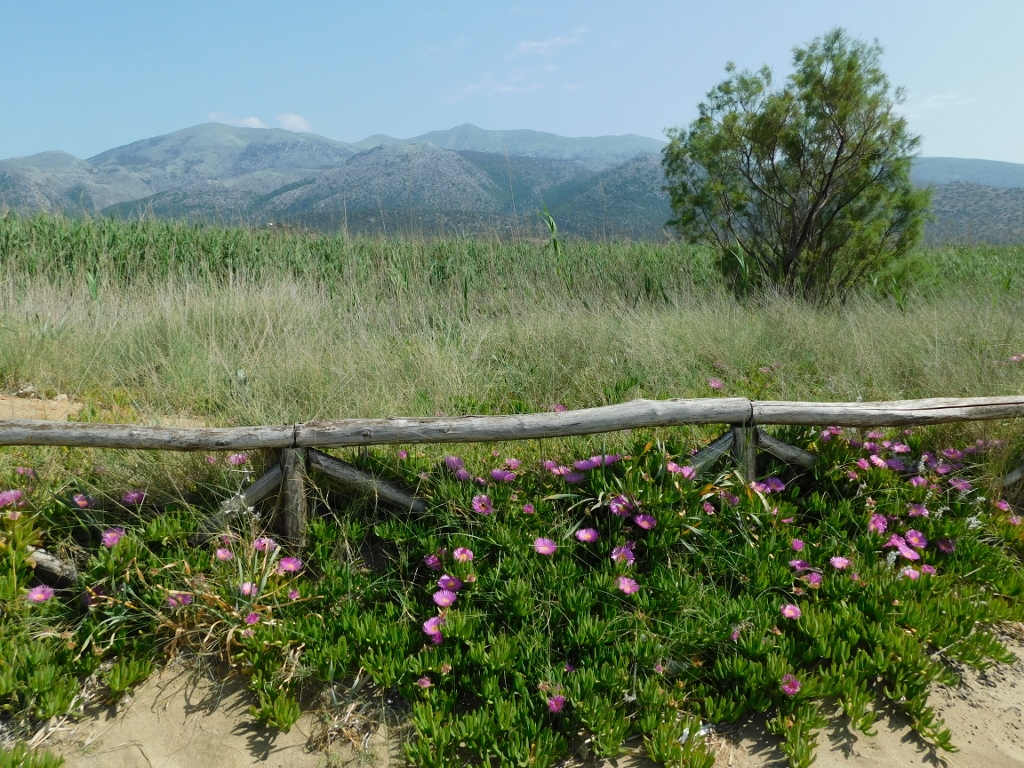 Marshy area east of Malia
Marshy area east of Malia
There is also a protected area on the other side of the road, continuing from the locally famous Potamos Beach. Here, there are sand dunes with specific vegetation growing on top and this part is separated by a fence to emphasise that walking here should be avoided in order to prevent damage to the vegetation. The plants growing here are adapted to the sandy base and their extensive root systems prevent the sand from dispersing due to the influence of wind and sea, thus stabilising the dunes in this area.
 Protected dunes (left) and Potamos Beach (right)
Protected dunes (left) and Potamos Beach (right)
However, since we were already there, one group member wanted to take a swim and we easily agreed to all go to the beach together – Marko in order to swim and the rest of us to “cheer” for him. He was brave (and resistant to the cold water), so it was quite clear that he immensely enjoyed swimming. The rest of us watched him from the shore, occasionally dipping our feet in the water.
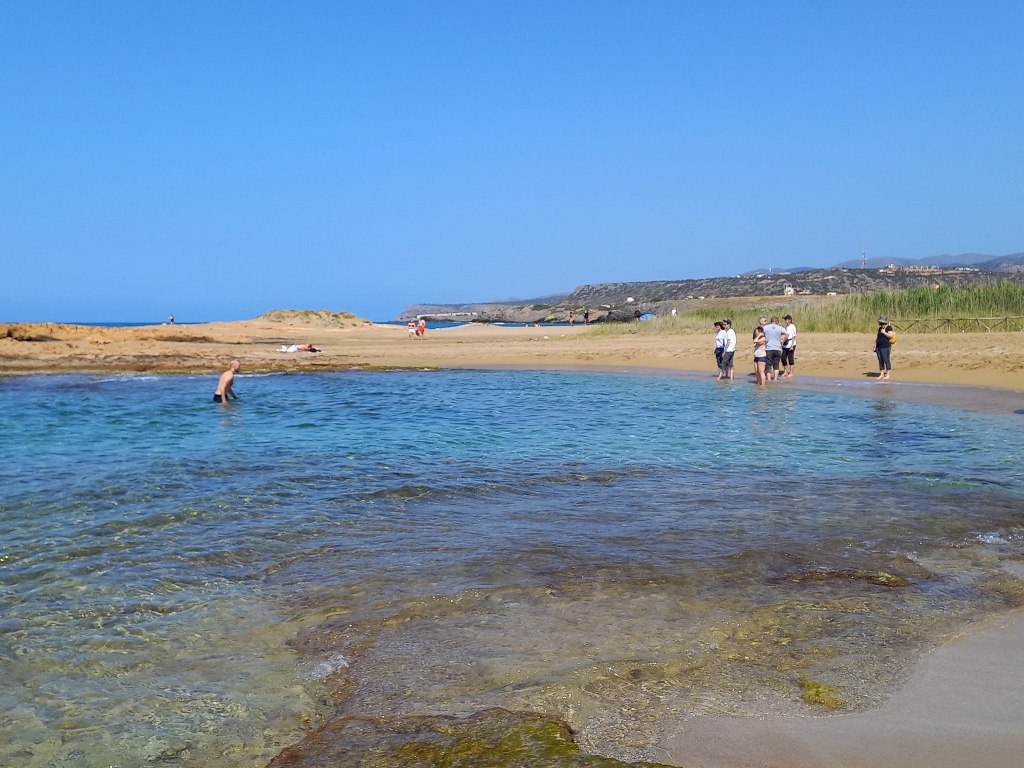 Waiting for Marko to come out of the sea after a good swim
Waiting for Marko to come out of the sea after a good swim
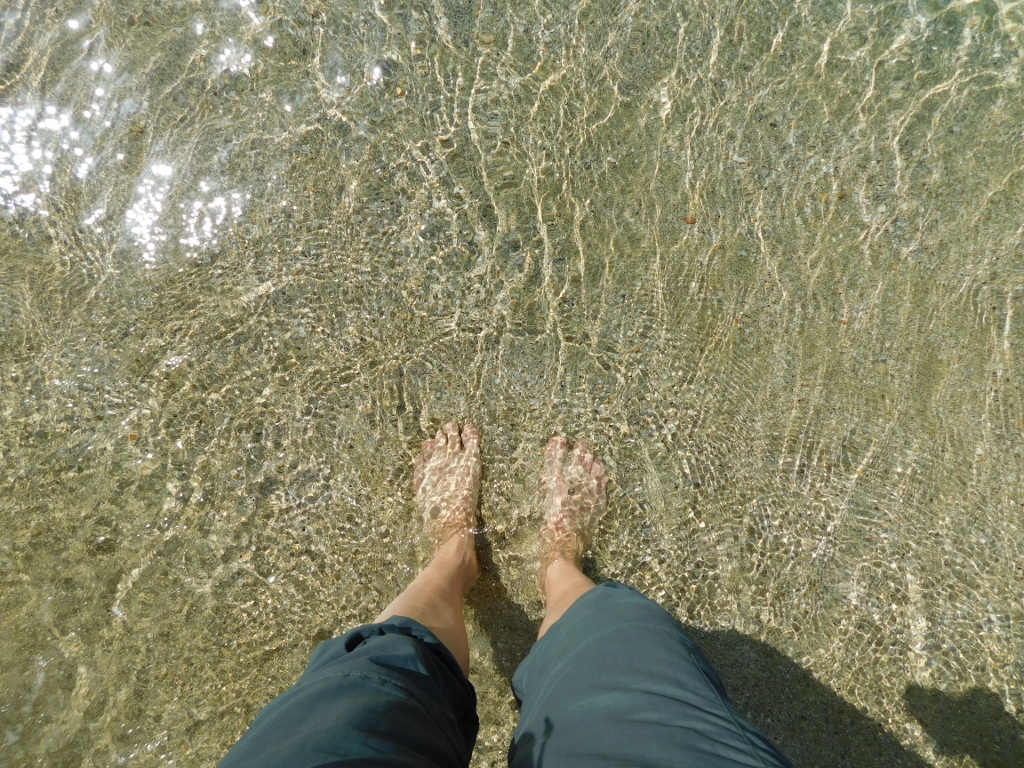 Dipping the feet of the “brave” ones
Dipping the feet of the “brave” ones
When we were all sufficiently dry and changed back into our shoes, we returned to the hotel and then we scattered a bit. Sonja and I walked towards the centre since both of us, for our own reasons, don’t like to eat late in the day. Along the way, we were greeted by a beautiful flower growing by the street we were walking on. There were others, but some had already withered, while this one was at the peak of its blooming. It is a bird of paradise (Strelitzia reginae). Whoever is responsible for creating life on Earth, whether it is God or nature, they are truly supremely imaginative and skilled.
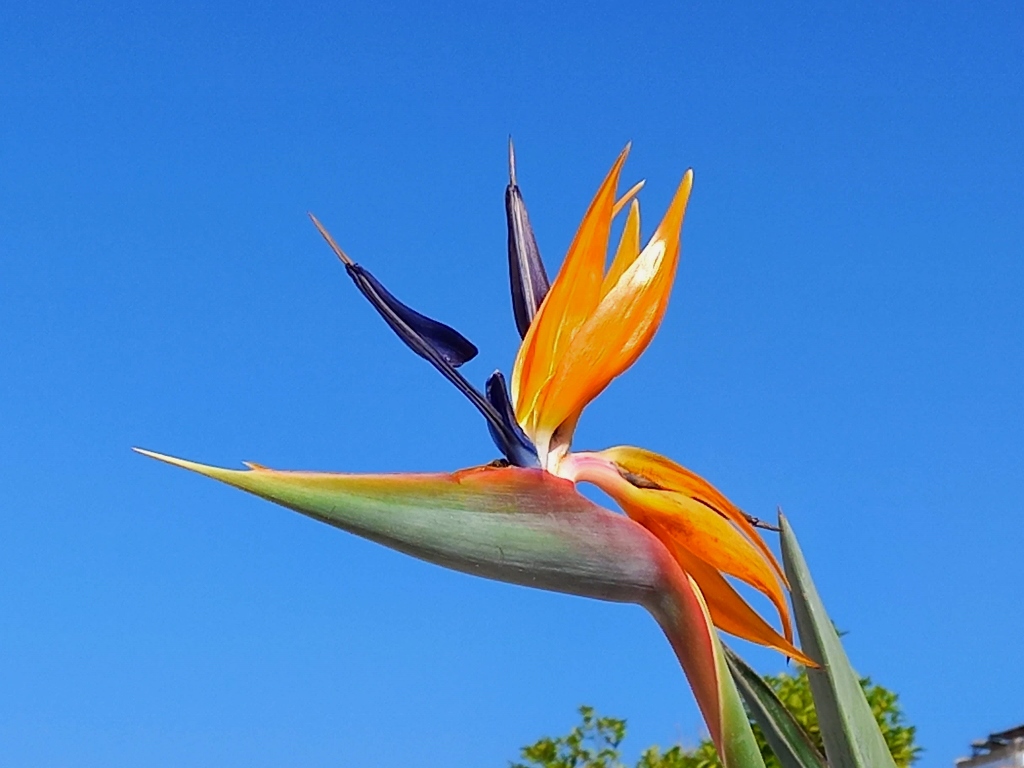 Bird of paradise
Bird of paradise
Sonja and I found a restaurant that we really liked, so we ordered various delicious items there. To start, I ordered a beer. Since I was one of the three drivers on this trip, I could only afford to have a beer in the evening, so I didn’t miss out on such opportunities.
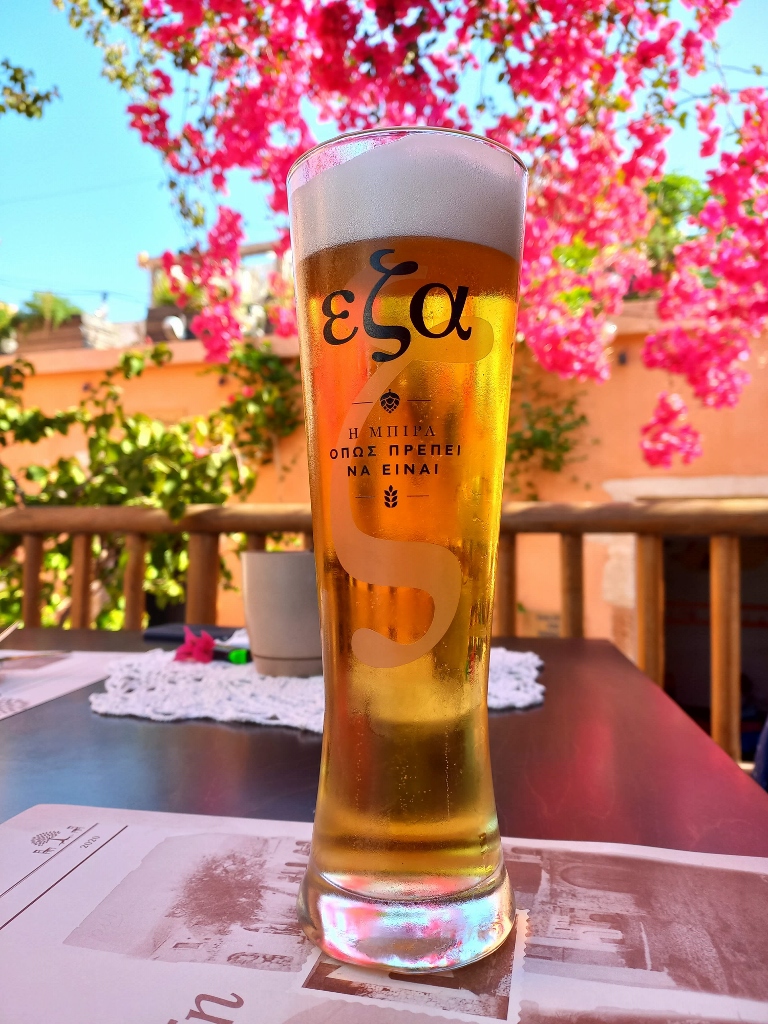 Beer in Malia
Beer in Malia
The restaurant offered a lot of traditional food, so everything was in line with that: hot bread seasoned with olive oil and aromatic spices made from local plants, the obligatory tzatziki for me, a wonderful cheese pie that I mostly filmed to remind myself of how such a pie can be prepared and served, and finally – I wanted to try how snails are made in Crete. There was also a lovely salad of cherry tomatoes and Sonja opted for fish, but I wanted to eat something different. I often had fish in the following days, so everything was just right.
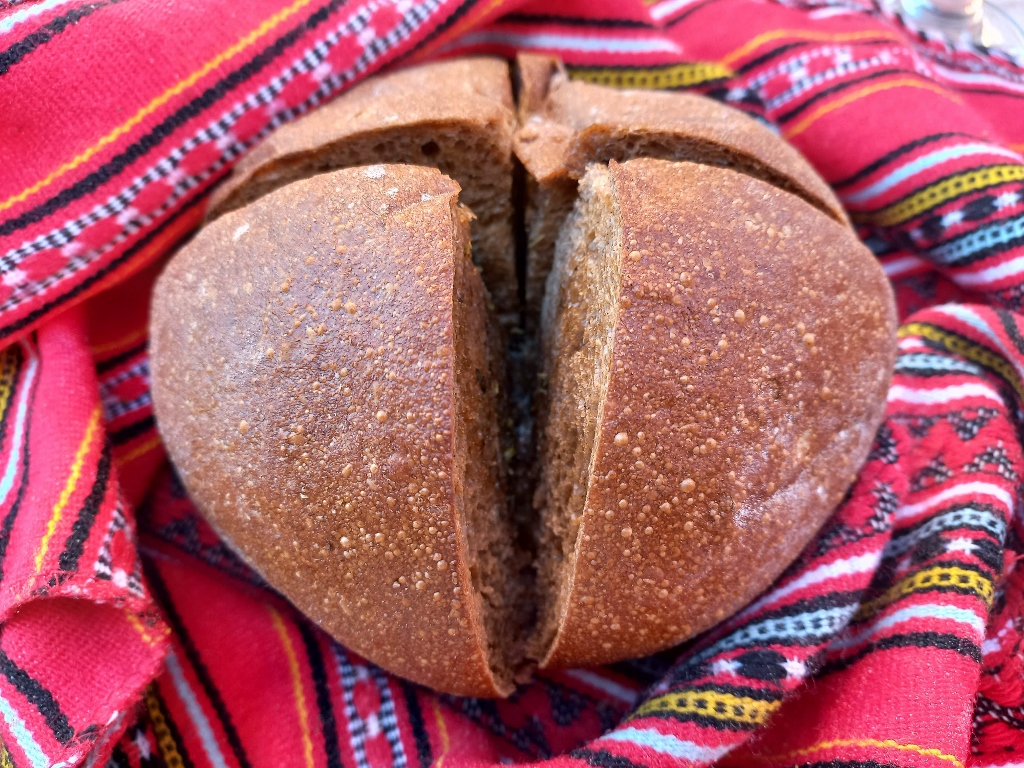 Part of the dinner in Malia
Part of the dinner in Malia
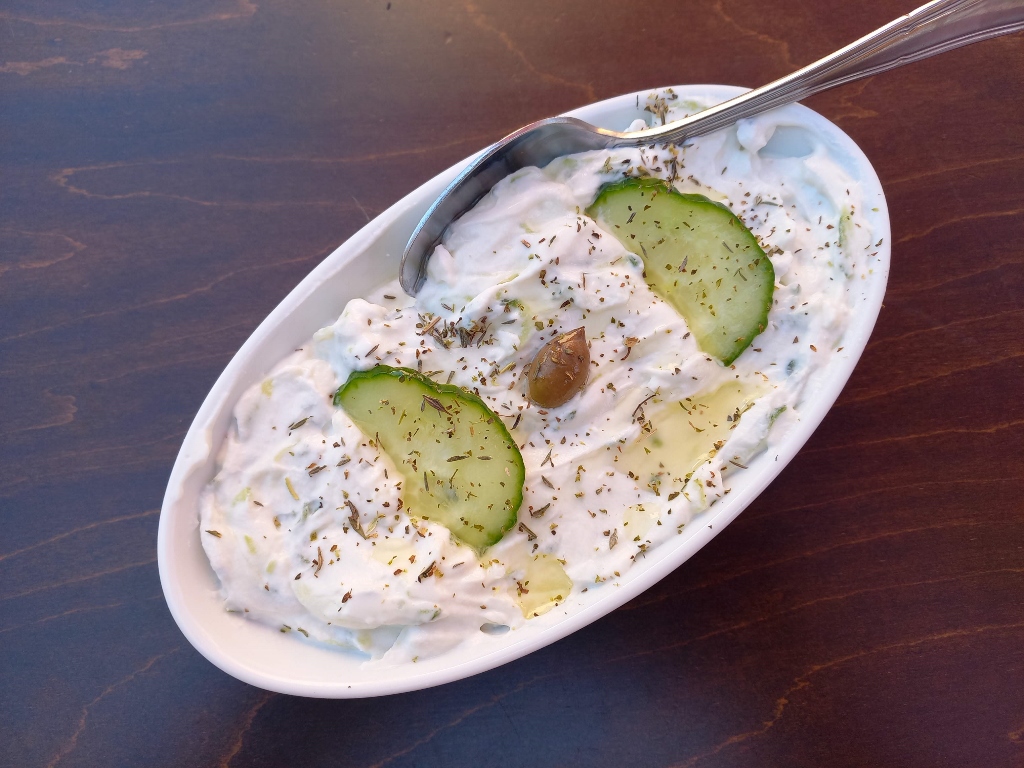 Part of the dinner in Malia
Part of the dinner in Malia
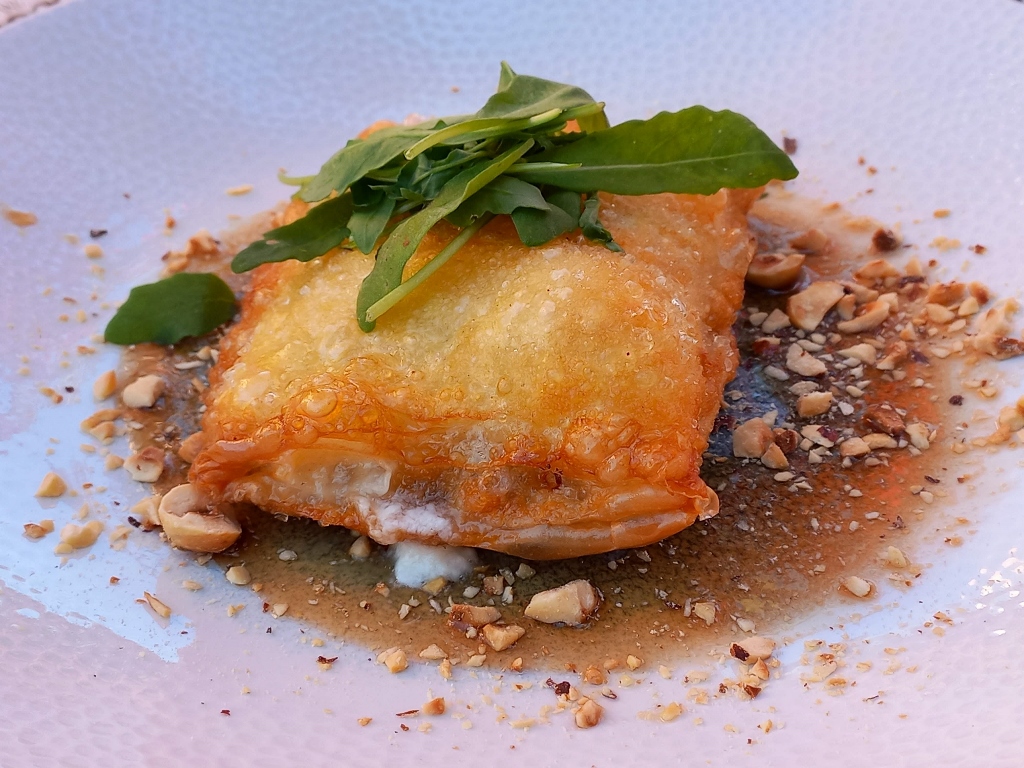 Part of the dinner in Malia
Part of the dinner in Malia
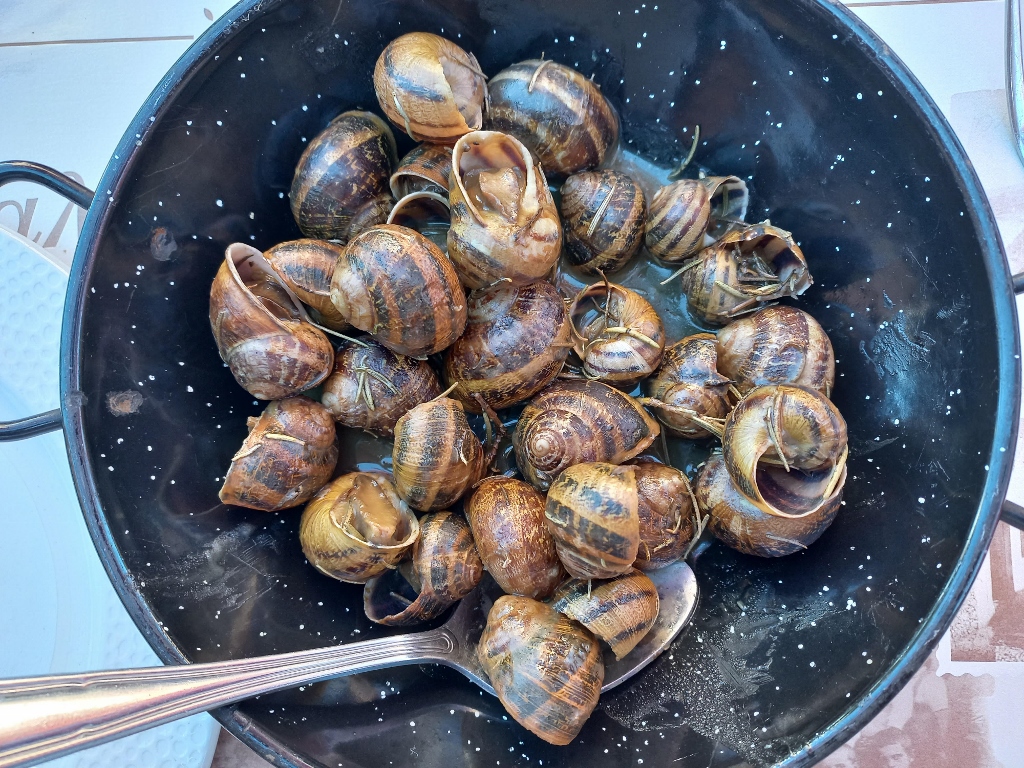 Part of the dinner in Malia
Part of the dinner in Malia
After the dinner, we returned to the hotel, where from the terrace of our apartment, I managed to film several birds that were landing in the evening on what exists in human settlements – antennas and wires.
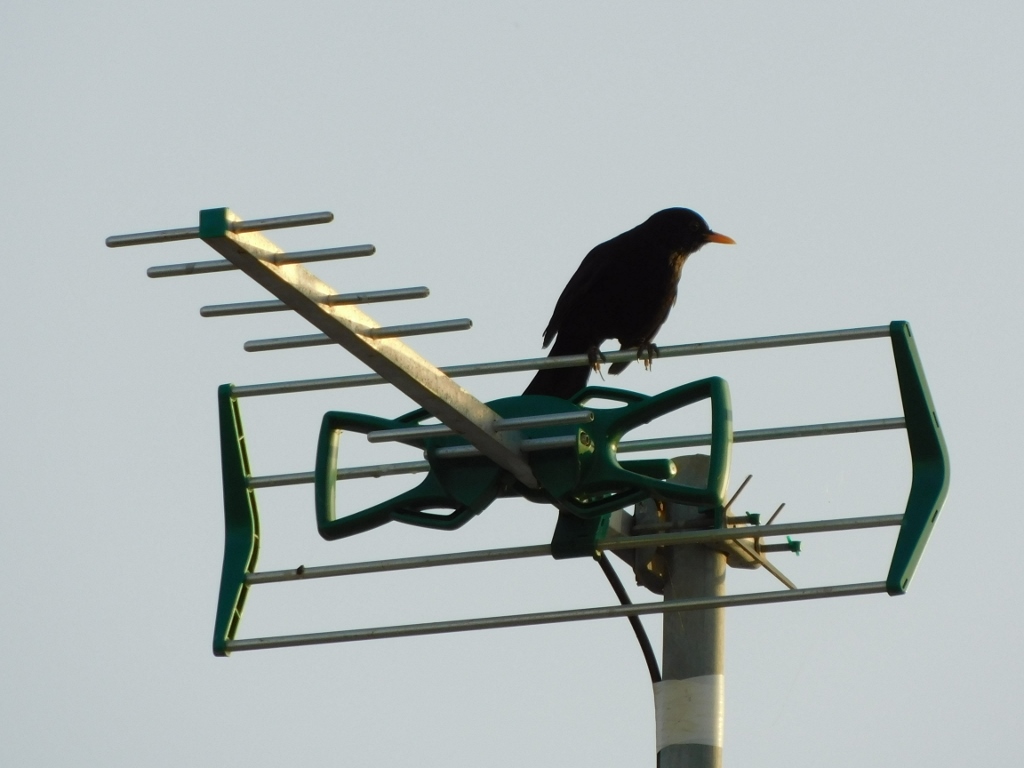 Common blackbird (Turdus merula)
Common blackbird (Turdus merula)
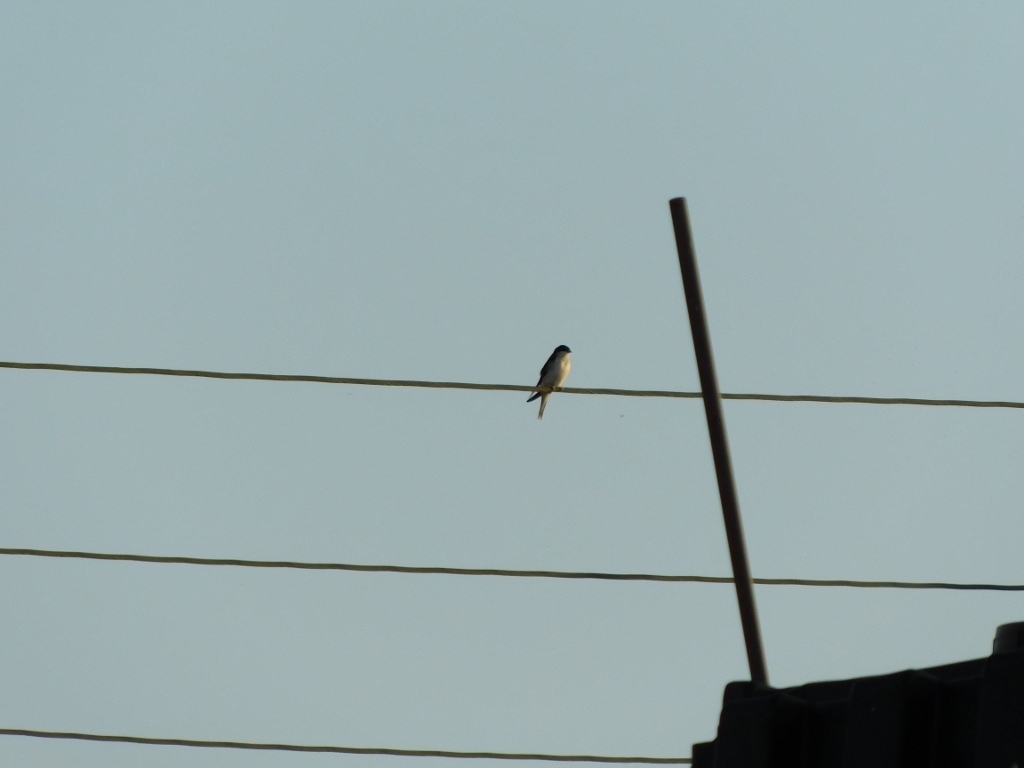 Western house martin (Delichon urbicum)
Western house martin (Delichon urbicum)
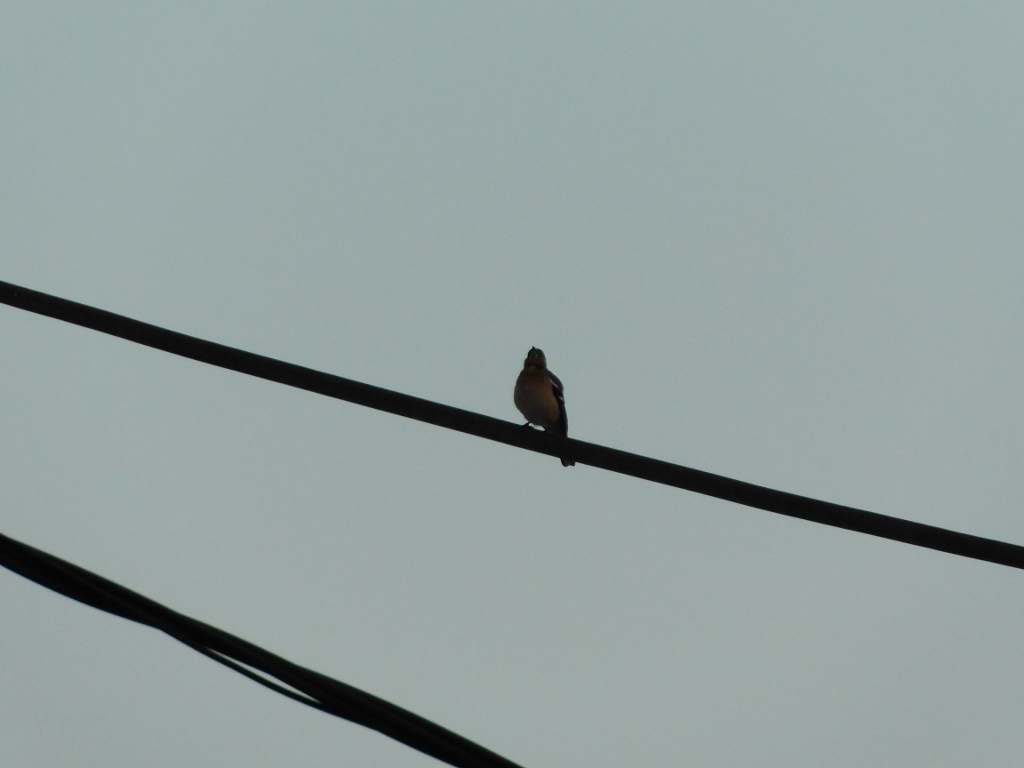 Male Eurasian chaffinch (Fringilla coelebs)
Male Eurasian chaffinch (Fringilla coelebs)
We also socialised again with the group members because we were all waiting for a Greek colleague/ornithologist whom Saša and Ljilja have known for years. When he arrived, most of the group went to dinner with him, but Sonja and I decided to retire for sleep. The next day was going to be an early start.
On this day, we all woke up early, so we also started early, around 7 in the morning, before breakfast. The reason was that we wanted to drive a few kilometres east to have a better and peaceful look, without the presence of a larger number of people, at the area with sand dunes and the marshy part near Malia. We had already been there the previous day, but then we couldn’t see many birds, so we thought it would be better to come back in the morning when the areas around Potamos Beach were deserted.
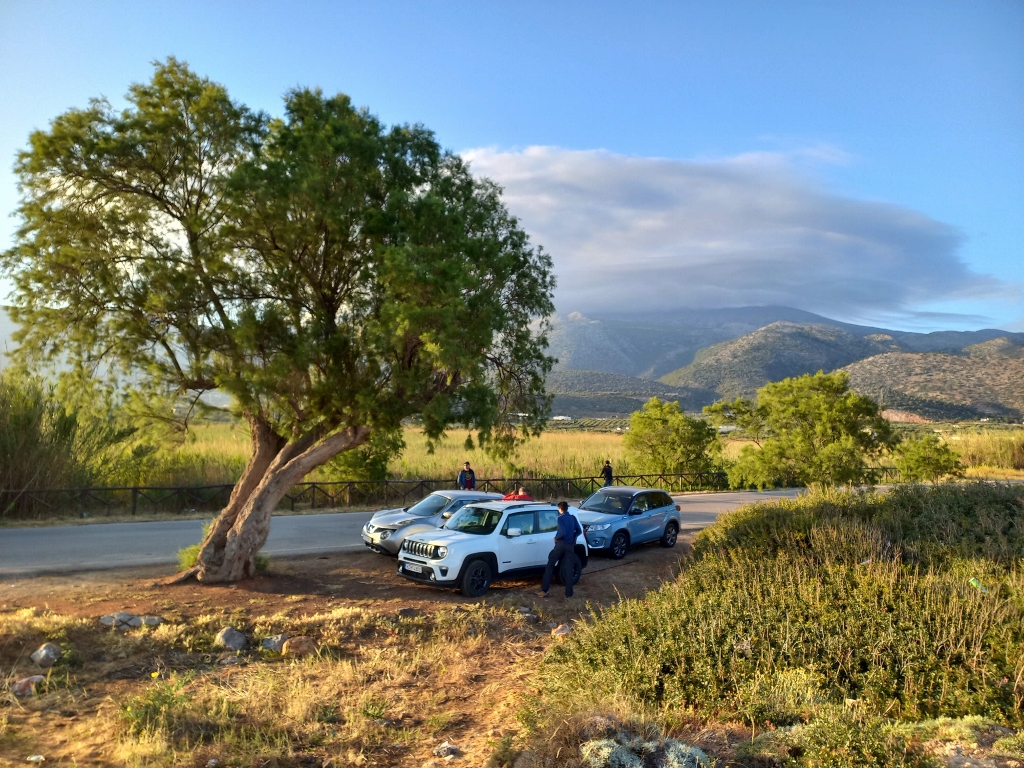 Morning search for birds
Morning search for birds
I didn’t really excel here and only managed to take a photo of one more crested lark (Galerida cristata), but it didn’t bother me much because the view all around was very beautiful.
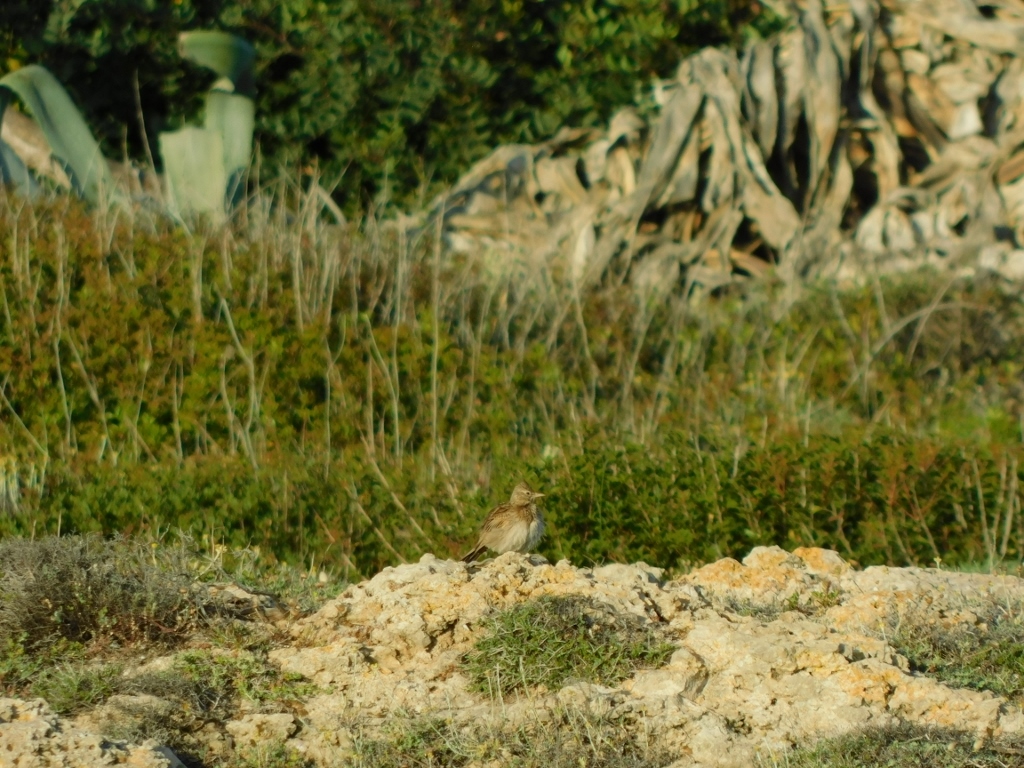 Crested lark
Crested lark
It turned out that at the first place we stopped, there was no intended entrance to the marshy area because there was a fence clearly set up everywhere, so we just observed the tall reeds there.
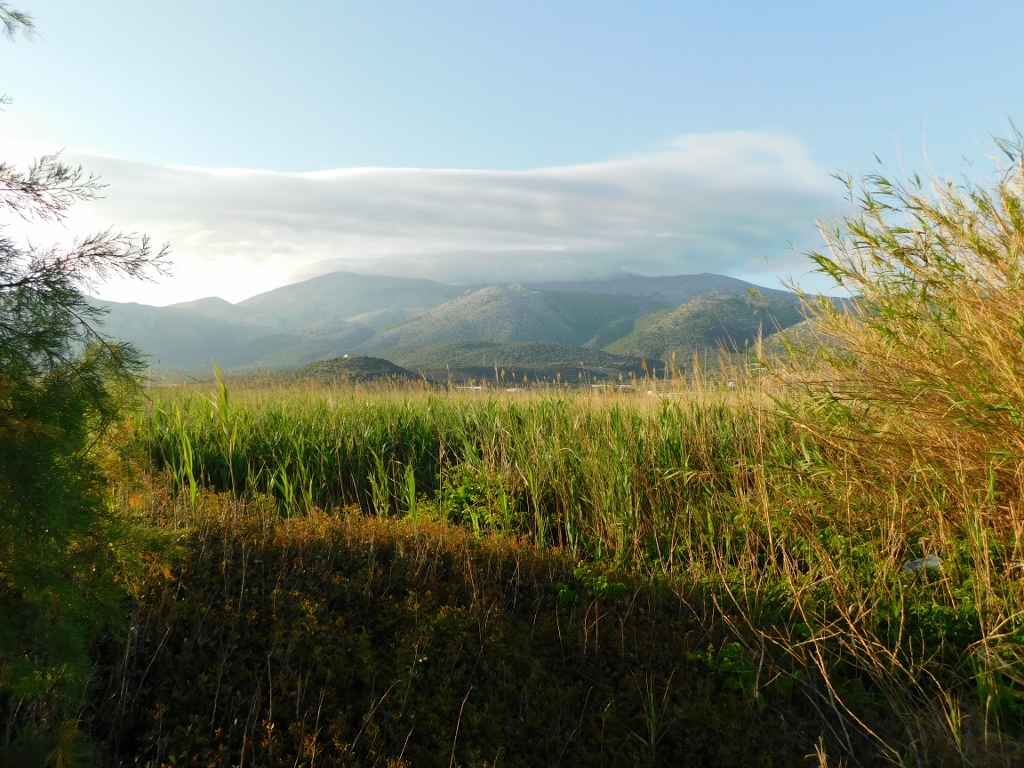 Area east of Malia
Area east of Malia
But, discouraging passage into the marshy area didn’t apply to everyone – some, like the local ants, had made themselves a sort of a motorway that runs alongside the human asphalt road and then calmly turns wherever they wish.
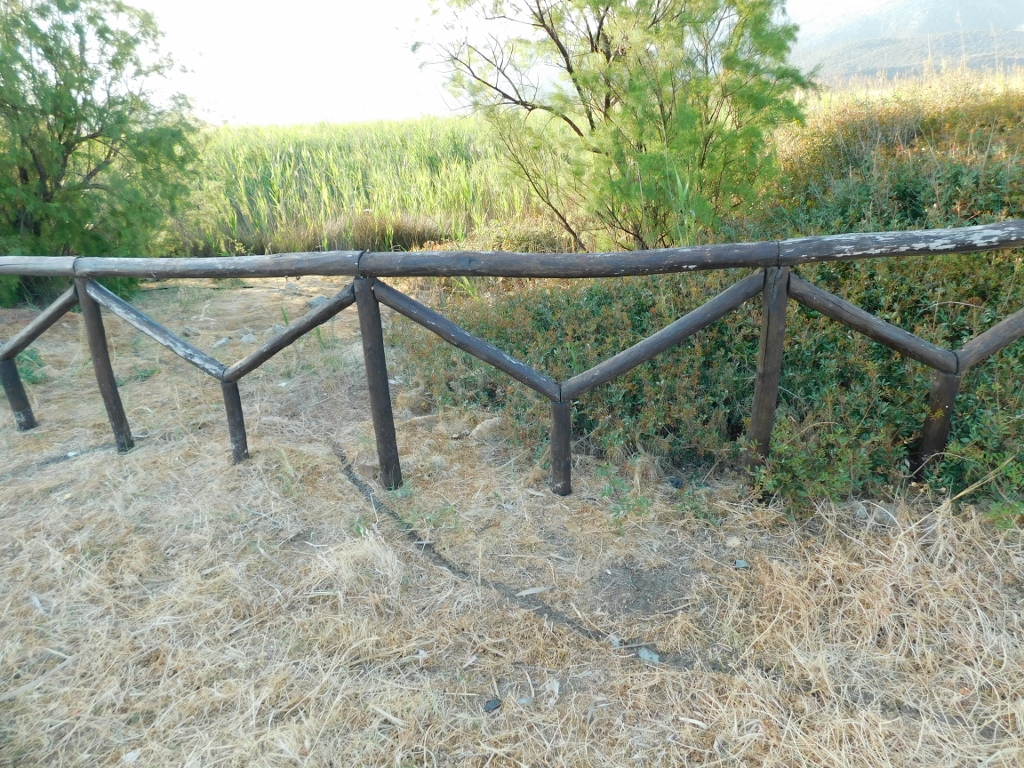 Ants’ “motorway”
Ants’ “motorway”
So we first moved to the beach, which was completely deserted this early in the morning.
 Beach east of Malia
Beach east of Malia
 Beach east of Malia
Beach east of Malia
Only members of our group walked around here, trying to spot different birds.
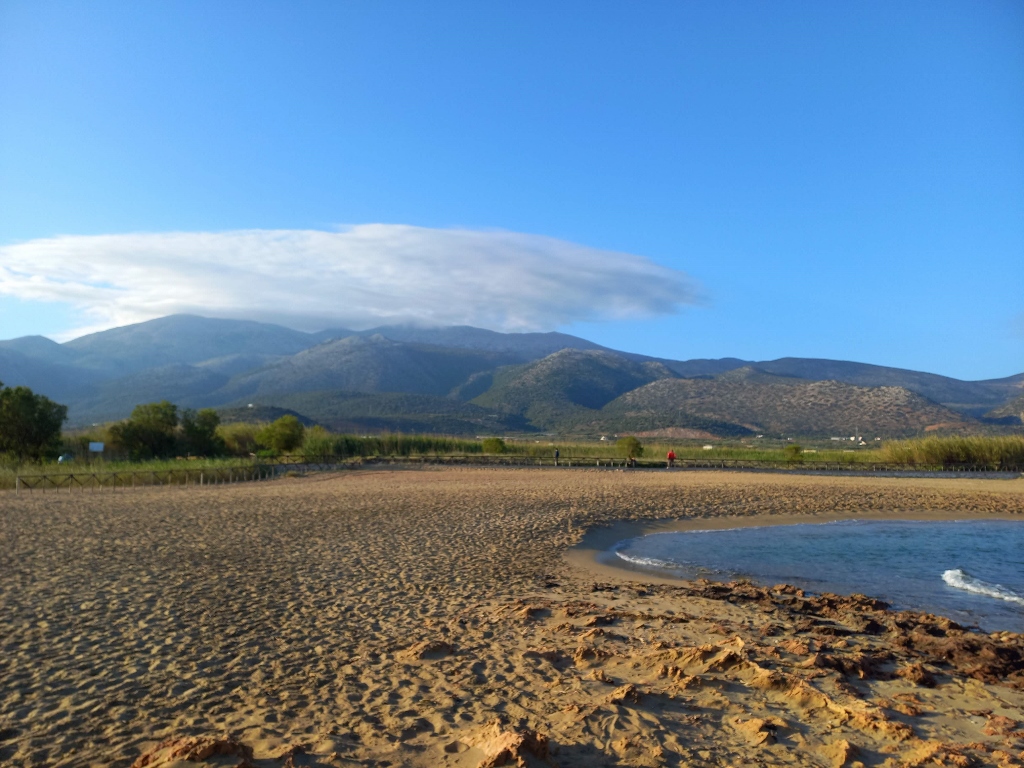 Beach east of Malia and birdwatchers
Beach east of Malia and birdwatchers
Thanks to Vuk, besides hooded crows (Corvus cornix), I managed to spot and even take a photo of a squacco heron (Ardeola ralloides).
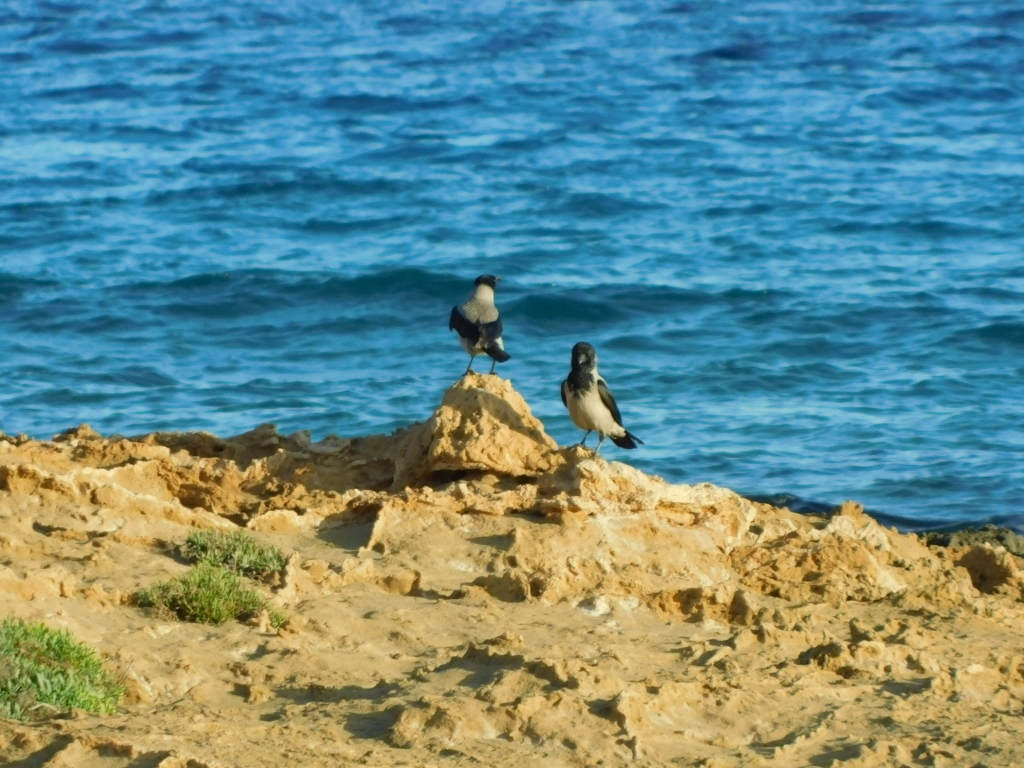 Hooded crows
Hooded crows
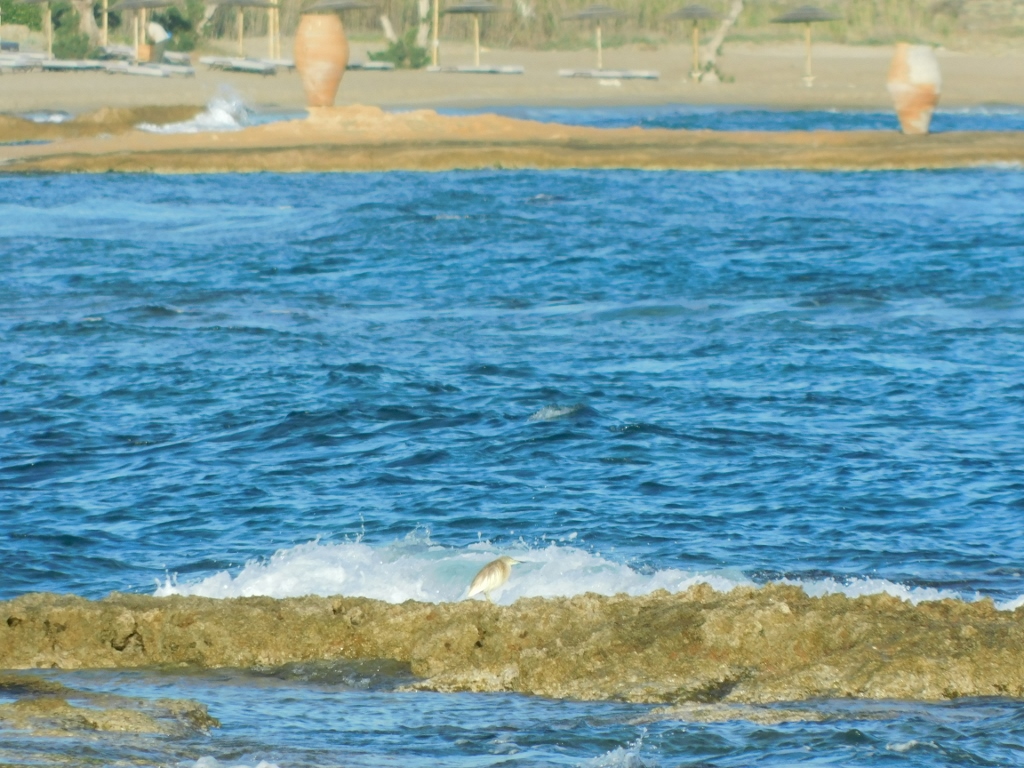 Squacco heron
Squacco heron
Then we all gathered again by the fence around the marshy area and followed it until the point where the fence ended, which coincided with a large map placed by the road showing the plan for some project for this area. As far as I could tell, there is a project to create paths here that would allow this habitat to be visited, but that was not yet the case in May 2024. So, we ventured a little into the dry parts that were easily accessible, but didn’t venture further.
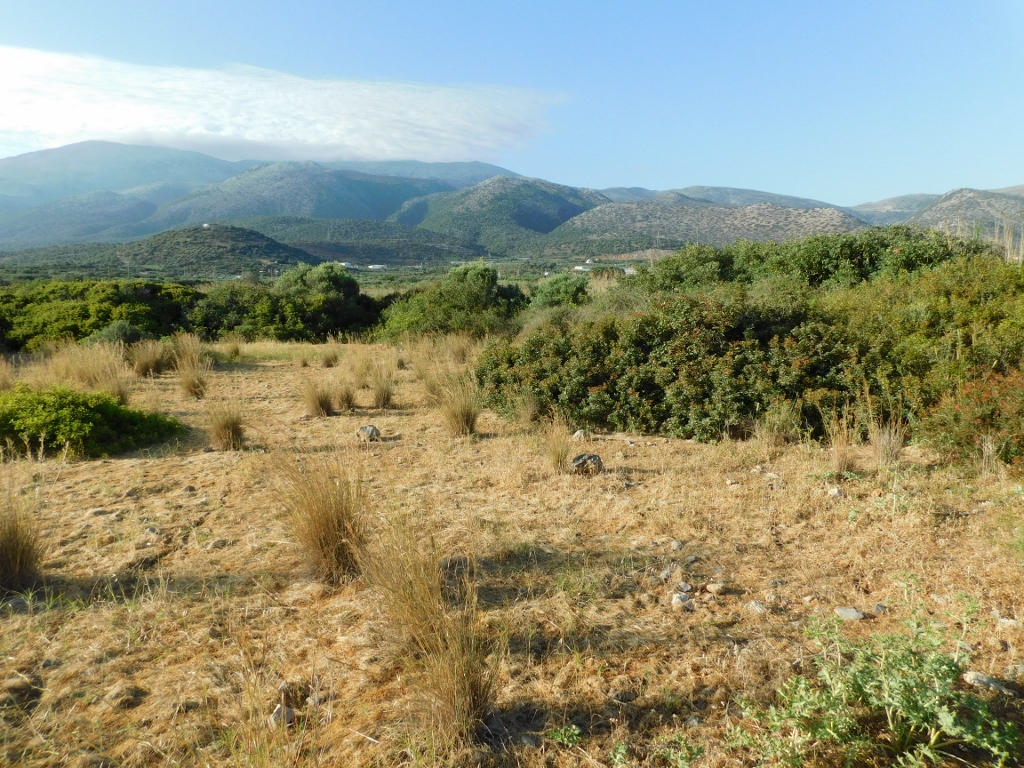 Part of the marshy area east of Malia
Part of the marshy area east of Malia
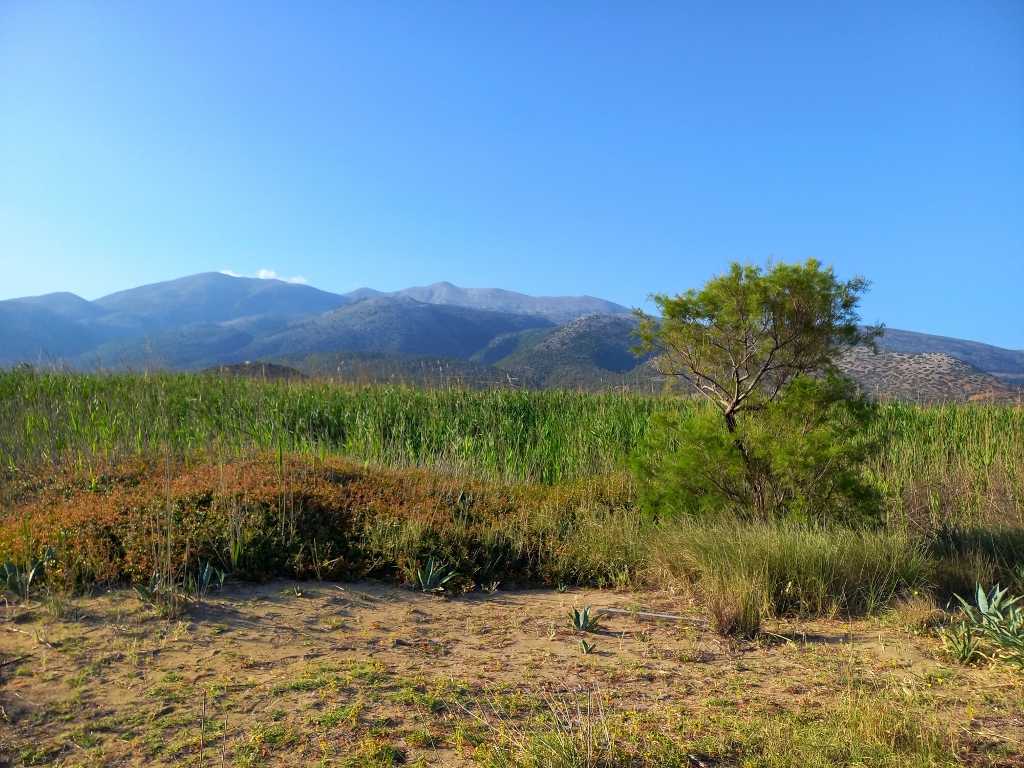 Part of the marshy area east of Malia
Part of the marshy area east of Malia
 Part of the marshy area east of Malia
Part of the marshy area east of Malia
Here, the more knowledgeable birdwatchers clearly spotted several species, including quite a few Eleonora’s falcons (Falco eleonorae) that would remain out of reach for me to capture by camera until the end of my stay. Although we saw them often, they were too small and fast for my camera (or me) to focus on while they were flying in the sky.
So, I had to be content with other, more peaceful animals that are easier to film. For example, ants and their “motorways” again.
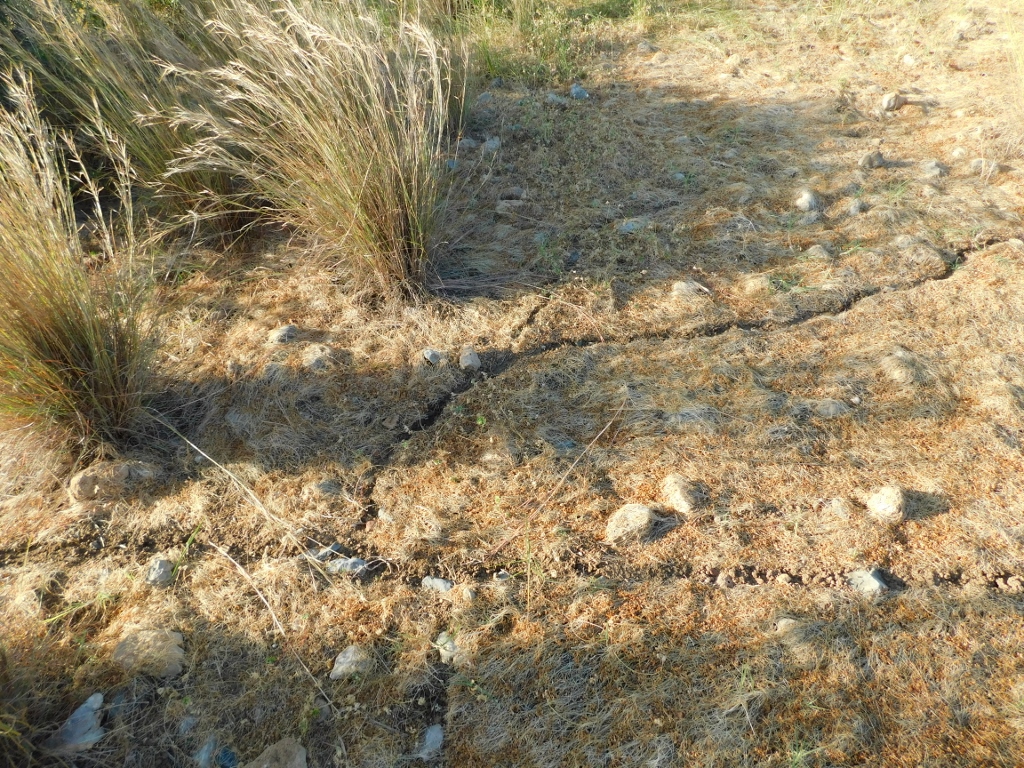 Ants’ “motorway”
Ants’ “motorway”
I was particularly delighted by an ant that determinedly transported a tiny little shell.
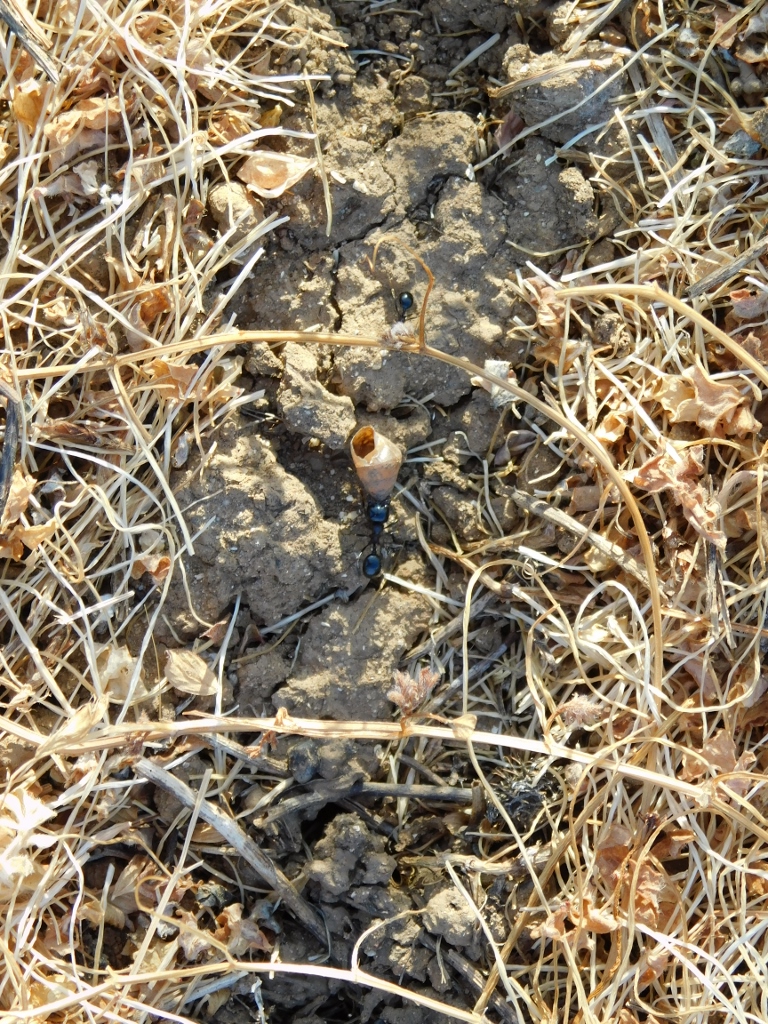 Hardworking as an ant!
Hardworking as an ant!
But thanks to Vuk, who found and placed a praying mantis on himself so that it would pose, I managed to take a photo of it as well.
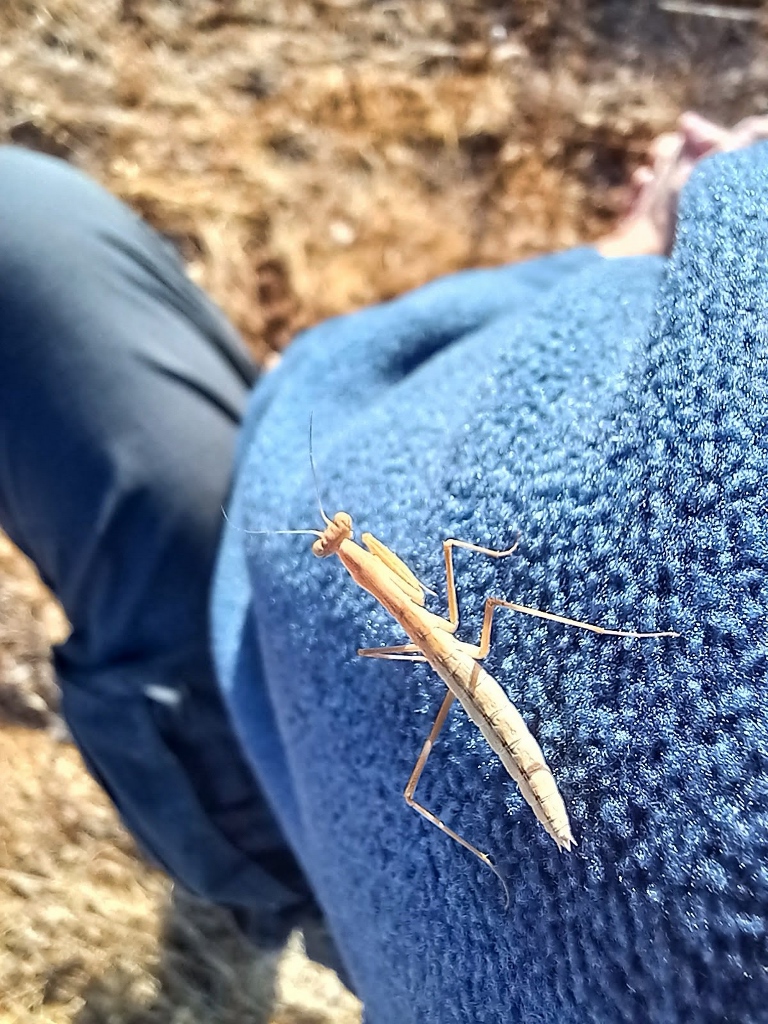 Praying mantis and Vuk
Praying mantis and Vuk
Soon we then returned to the road and walked again past Potamos Beach, which was beautiful but deserted in the early morning.
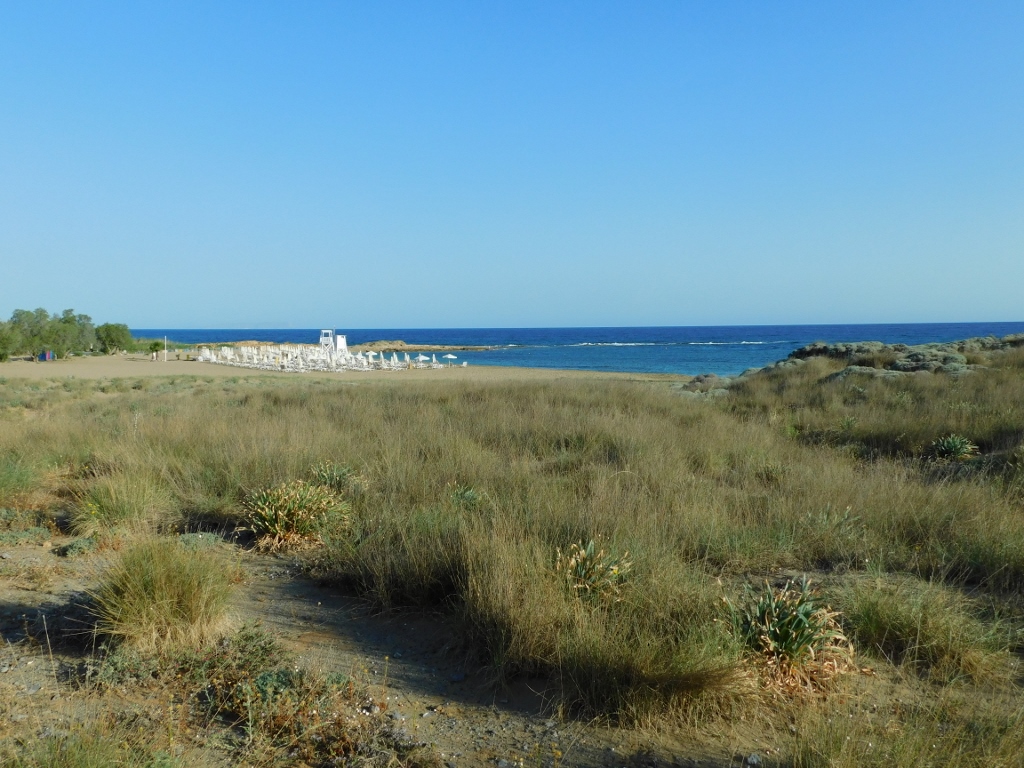 Potamos beach
Potamos beach
We went back to the cars and then returned to the apartment complex where we had breakfast and relaxed, enjoying another cup of morning coffee before setting off in search of birds in Crete.